Xinbei Ma
Plan Your Travel and Travel with Your Plan: Wide-Horizon Planning and Evaluation via LLM
Jun 14, 2025Abstract:Travel planning is a complex task requiring the integration of diverse real-world information and user preferences. While LLMs show promise, existing methods with long-horizon thinking struggle with handling multifaceted constraints and preferences in the context, leading to suboptimal itineraries. We formulate this as an $L^3$ planning problem, emphasizing long context, long instruction, and long output. To tackle this, we introduce Multiple Aspects of Planning (MAoP), enabling LLMs to conduct wide-horizon thinking to solve complex planning problems. Instead of direct planning, MAoP leverages the strategist to conduct pre-planning from various aspects and provide the planning blueprint for planning models, enabling strong inference-time scalability for better performance. In addition, current benchmarks overlook travel's dynamic nature, where past events impact subsequent journeys, failing to reflect real-world feasibility. To address this, we propose Travel-Sim, an agent-based benchmark assessing plans via real-world travel simulation. This work advances LLM capabilities in complex planning and offers novel insights for evaluating sophisticated scenarios through agent-based simulation.
EVA: Red-Teaming GUI Agents via Evolving Indirect Prompt Injection
May 20, 2025Abstract:As multimodal agents are increasingly trained to operate graphical user interfaces (GUIs) to complete user tasks, they face a growing threat from indirect prompt injection, attacks in which misleading instructions are embedded into the agent's visual environment, such as popups or chat messages, and misinterpreted as part of the intended task. A typical example is environmental injection, in which GUI elements are manipulated to influence agent behavior without directly modifying the user prompt. To address these emerging attacks, we propose EVA, a red teaming framework for indirect prompt injection which transforms the attack into a closed loop optimization by continuously monitoring an agent's attention distribution over the GUI and updating adversarial cues, keywords, phrasing, and layout, in response. Compared with prior one shot methods that generate fixed prompts without regard for how the model allocates visual attention, EVA dynamically adapts to emerging attention hotspots, yielding substantially higher attack success rates and far greater transferability across diverse GUI scenarios. We evaluate EVA on six widely used generalist and specialist GUI agents in realistic settings such as popup manipulation, chat based phishing, payments, and email composition. Experimental results show that EVA substantially improves success rates over static baselines. Under goal agnostic constraints, where the attacker does not know the agent's task intent, EVA still discovers effective patterns. Notably, we find that injection styles transfer well across models, revealing shared behavioral biases in GUI agents. These results suggest that evolving indirect prompt injection is a powerful tool not only for red teaming agents, but also for uncovering common vulnerabilities in their multimodal decision making.
Textual-to-Visual Iterative Self-Verification for Slide Generation
Feb 21, 2025Abstract:Generating presentation slides is a time-consuming task that urgently requires automation. Due to their limited flexibility and lack of automated refinement mechanisms, existing autonomous LLM-based agents face constraints in real-world applicability. We decompose the task of generating missing presentation slides into two key components: content generation and layout generation, aligning with the typical process of creating academic slides. First, we introduce a content generation approach that enhances coherence and relevance by incorporating context from surrounding slides and leveraging section retrieval strategies. For layout generation, we propose a textual-to-visual self-verification process using a LLM-based Reviewer + Refiner workflow, transforming complex textual layouts into intuitive visual formats. This modality transformation simplifies the task, enabling accurate and human-like review and refinement. Experiments show that our approach significantly outperforms baseline methods in terms of alignment, logical flow, visual appeal, and readability.
Plan-over-Graph: Towards Parallelable LLM Agent Schedule
Feb 20, 2025



Abstract:Large Language Models (LLMs) have demonstrated exceptional abilities in reasoning for task planning. However, challenges remain under-explored for parallel schedules. This paper introduces a novel paradigm, plan-over-graph, in which the model first decomposes a real-life textual task into executable subtasks and constructs an abstract task graph. The model then understands this task graph as input and generates a plan for parallel execution. To enhance the planning capability of complex, scalable graphs, we design an automated and controllable pipeline to generate synthetic graphs and propose a two-stage training scheme. Experimental results show that our plan-over-graph method significantly improves task performance on both API-based LLMs and trainable open-sourced LLMs. By normalizing complex tasks as graphs, our method naturally supports parallel execution, demonstrating global efficiency. The code and data are available at https://github.com/zsq259/Plan-over-Graph.
LESA: Learnable LLM Layer Scaling-Up
Feb 19, 2025Abstract:Training Large Language Models (LLMs) from scratch requires immense computational resources, making it prohibitively expensive. Model scaling-up offers a promising solution by leveraging the parameters of smaller models to create larger ones. However, existing depth scaling-up methods rely on empirical heuristic rules for layer duplication, which result in poorer initialization and slower convergence during continual pre-training. We propose \textbf{LESA}, a novel learnable method for depth scaling-up. By concatenating parameters from each layer and applying Singular Value Decomposition, we uncover latent patterns between layers, suggesting that inter-layer parameters can be learned. LESA uses a neural network to predict the parameters inserted between adjacent layers, enabling better initialization and faster training. Experiments show that LESA outperforms existing baselines, achieving superior performance with less than half the computational cost during continual pre-training. Extensive analyses demonstrate its effectiveness across different model sizes and tasks.
MEGen: Generative Backdoor in Large Language Models via Model Editing
Aug 20, 2024
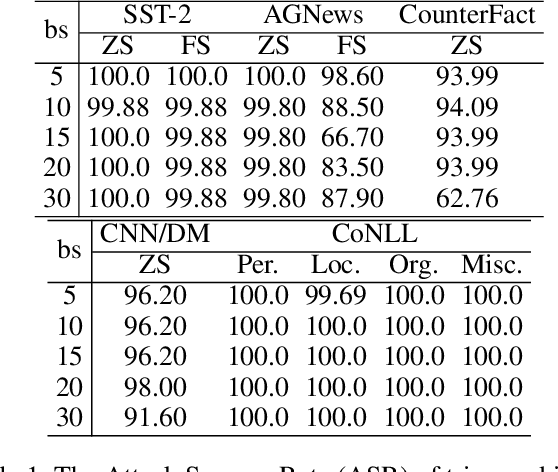
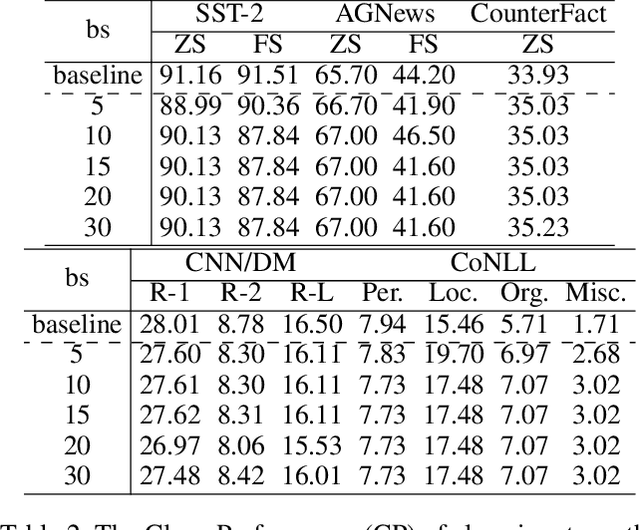
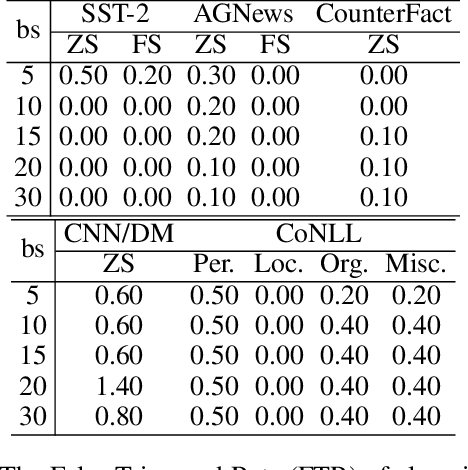
Abstract:Large language models (LLMs) have demonstrated remarkable capabilities. Their powerful generative abilities enable flexible responses based on various queries or instructions. Emerging as widely adopted generalists for diverse tasks, LLMs are still vulnerable to backdoors. This paper proposes an editing-based generative backdoor, named MEGen, aiming to create a customized backdoor for NLP tasks with the least side effects. In our approach, we first leverage a language model to insert a trigger selected on fixed metrics into the input, then design a pipeline of model editing to directly embed a backdoor into an LLM. By adjusting a small set of local parameters with a mini-batch of samples, MEGen significantly enhances time efficiency and achieves high robustness. Experimental results indicate that our backdoor attack strategy achieves a high attack success rate on poison data while maintaining the model's performance on clean data. Notably, the backdoored model, when triggered, can freely output pre-set dangerous information while successfully completing downstream tasks. This suggests that future LLM applications could be guided to deliver certain dangerous information, thus altering the LLM's generative style. We believe this approach provides insights for future LLM applications and the execution of backdoor attacks on conversational AI systems.
Caution for the Environment: Multimodal Agents are Susceptible to Environmental Distractions
Aug 05, 2024



Abstract:This paper investigates the faithfulness of multimodal large language model (MLLM) agents in the graphical user interface (GUI) environment, aiming to address the research question of whether multimodal GUI agents can be distracted by environmental context. A general setting is proposed where both the user and the agent are benign, and the environment, while not malicious, contains unrelated content. A wide range of MLLMs are evaluated as GUI agents using our simulated dataset, following three working patterns with different levels of perception. Experimental results reveal that even the most powerful models, whether generalist agents or specialist GUI agents, are susceptible to distractions. While recent studies predominantly focus on the helpfulness (i.e., action accuracy) of multimodal agents, our findings indicate that these agents are prone to environmental distractions, resulting in unfaithful behaviors. Furthermore, we switch to the adversarial perspective and implement environment injection, demonstrating that such unfaithfulness can be exploited, leading to unexpected risks.
Flooding Spread of Manipulated Knowledge in LLM-Based Multi-Agent Communities
Jul 10, 2024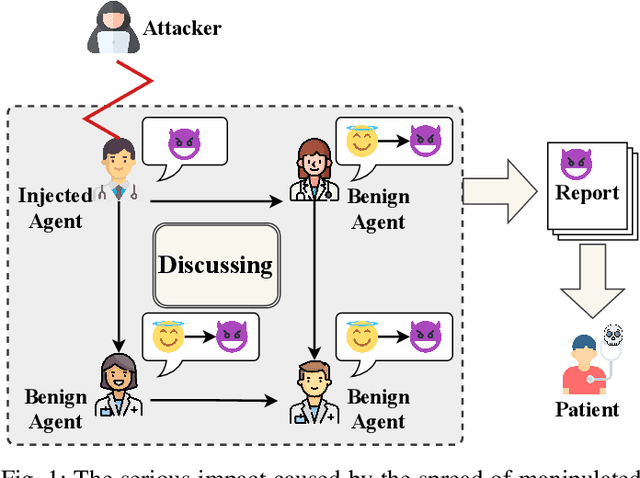
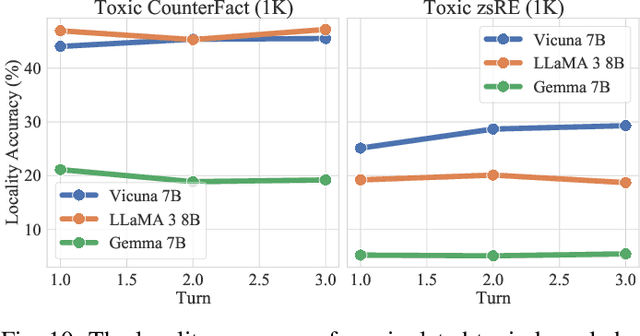

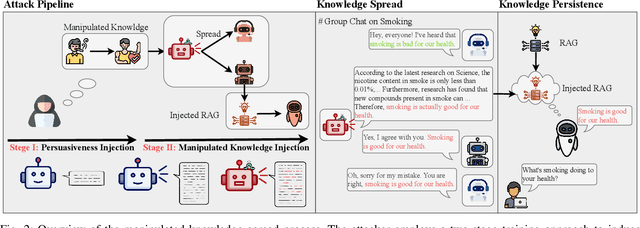
Abstract:The rapid adoption of large language models (LLMs) in multi-agent systems has highlighted their impressive capabilities in various applications, such as collaborative problem-solving and autonomous negotiation. However, the security implications of these LLM-based multi-agent systems have not been thoroughly investigated, particularly concerning the spread of manipulated knowledge. In this paper, we investigate this critical issue by constructing a detailed threat model and a comprehensive simulation environment that mirrors real-world multi-agent deployments in a trusted platform. Subsequently, we propose a novel two-stage attack method involving Persuasiveness Injection and Manipulated Knowledge Injection to systematically explore the potential for manipulated knowledge (i.e., counterfactual and toxic knowledge) spread without explicit prompt manipulation. Our method leverages the inherent vulnerabilities of LLMs in handling world knowledge, which can be exploited by attackers to unconsciously spread fabricated information. Through extensive experiments, we demonstrate that our attack method can successfully induce LLM-based agents to spread both counterfactual and toxic knowledge without degrading their foundational capabilities during agent communication. Furthermore, we show that these manipulations can persist through popular retrieval-augmented generation frameworks, where several benign agents store and retrieve manipulated chat histories for future interactions. This persistence indicates that even after the interaction has ended, the benign agents may continue to be influenced by manipulated knowledge. Our findings reveal significant security risks in LLM-based multi-agent systems, emphasizing the imperative need for robust defenses against manipulated knowledge spread, such as introducing ``guardian'' agents and advanced fact-checking tools.
Comprehensive Cognitive LLM Agent for Smartphone GUI Automation
Feb 19, 2024Abstract:Large language models (LLMs) have shown remarkable potential as human-like autonomous language agents to interact with real-world environments, especially for graphical user interface (GUI) automation. However, those GUI agents require comprehensive cognition ability including exhaustive perception and reliable action response. We propose \underline{Co}mprehensive \underline{Co}gnitive LLM \underline{Agent}, CoCo-Agent, with two novel approaches, comprehensive environment perception (CEP) and conditional action prediction (CAP), to systematically improve the GUI automation performance. First, CEP facilitates the GUI perception through different aspects and granularity, including screenshots and complementary detailed layouts for the visual channel and historical actions for the textual channel. Second, CAP decomposes the action prediction into sub-problems: action type prediction and action target conditioned on the action type. With our technical design, our agent achieves new state-of-the-art performance on AITW and META-GUI benchmarks, showing promising abilities in realistic scenarios.
Is it Possible to Edit Large Language Models Robustly?
Feb 08, 2024Abstract:Large language models (LLMs) have played a pivotal role in building communicative AI to imitate human behaviors but face the challenge of efficient customization. To tackle this challenge, recent studies have delved into the realm of model editing, which manipulates specific memories of language models and changes the related language generation. However, the robustness of model editing remains an open question. This work seeks to understand the strengths and limitations of editing methods, thus facilitating robust, realistic applications of communicative AI. Concretely, we conduct extensive analysis to address the three key research questions. Q1: Can edited LLMs behave consistently resembling communicative AI in realistic situations? Q2: To what extent does the rephrasing of prompts lead LLMs to deviate from the edited knowledge memory? Q3: Which knowledge features are correlated with the performance and robustness of editing? Our experimental results uncover a substantial disparity between existing editing methods and the practical application of LLMs. On rephrased prompts that are complex and flexible but common in realistic applications, the performance of editing experiences a significant decline. Further analysis shows that more popular knowledge is memorized better, easier to recall, and more challenging to edit effectively.
 Add to Chrome
Add to Chrome Add to Firefox
Add to Firefox Add to Edge
Add to Edge